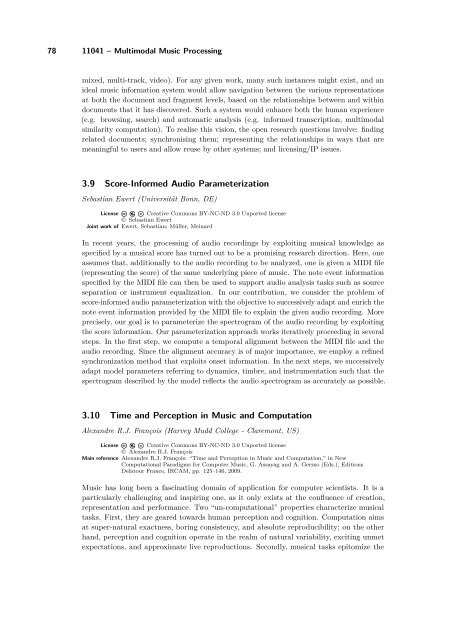Volume 1, Issue 1, January 2011 - DROPS - Schloss Dagstuhl
Volume 1, Issue 1, January 2011 - DROPS - Schloss Dagstuhl
Volume 1, Issue 1, January 2011 - DROPS - Schloss Dagstuhl
Create successful ePaper yourself
Turn your PDF publications into a flip-book with our unique Google optimized e-Paper software.
78 11041 – Multimodal Music Processing<br />
mixed, multi-track, video). For any given work, many such instances might exist, and an<br />
ideal music information system would allow navigation between the various representations<br />
at both the document and fragment levels, based on the relationships between and within<br />
documents that it has discovered. Such a system would enhance both the human experience<br />
(e.g. browsing, search) and automatic analysis (e.g. informed transcription, multimodal<br />
similarity computation). To realise this vision, the open research questions involve: finding<br />
related documents; synchronising them; representing the relationships in ways that are<br />
meaningful to users and allow reuse by other systems; and licensing/IP issues.<br />
3.9 Score-Informed Audio Parameterization<br />
Sebastian Ewert (Universität Bonn, DE)<br />
License Creative Commons BY-NC-ND 3.0 Unported license<br />
© Sebastian Ewert<br />
Joint work of Ewert, Sebastian; Müller, Meinard<br />
In recent years, the processing of audio recordings by exploiting musical knowledge as<br />
specified by a musical score has turned out to be a promising research direction. Here, one<br />
assumes that, additionally to the audio recording to be analyzed, one is given a MIDI file<br />
(representing the score) of the same underlying piece of music. The note event information<br />
specified by the MIDI file can then be used to support audio analysis tasks such as source<br />
separation or instrument equalization. In our contribution, we consider the problem of<br />
score-informed audio parameterization with the objective to successively adapt and enrich the<br />
note event information provided by the MIDI file to explain the given audio recording. More<br />
precisely, our goal is to parameterize the spectrogram of the audio recording by exploiting<br />
the score information. Our parameterization approach works iteratively proceeding in several<br />
steps. In the first step, we compute a temporal alignment between the MIDI file and the<br />
audio recording. Since the alignment accuracy is of major importance, we employ a refined<br />
synchronization method that exploits onset information. In the next steps, we successively<br />
adapt model parameters referring to dynamics, timbre, and instrumentation such that the<br />
spectrogram described by the model reflects the audio spectrogram as accurately as possible.<br />
3.10 Time and Perception in Music and Computation<br />
Alexandre R.J. François (Harvey Mudd College - Claremont, US)<br />
License Creative Commons BY-NC-ND 3.0 Unported license<br />
© Alexandre R.J. François<br />
Main reference Alexandre R.J. François: “Time and Perception in Music and Computation,” in New<br />
Computational Paradigms for Computer Music, G. Assayag and A. Gerzso (Eds.), Editions<br />
Delatour France, IRCAM, pp. 125–146, 2009.<br />
Music has long been a fascinating domain of application for computer scientists. It is a<br />
particularly challenging and inspiring one, as it only exists at the confluence of creation,<br />
representation and performance. Two “un-computational” properties characterize musical<br />
tasks. First, they are geared towards human perception and cognition. Computation aims<br />
at super-natural exactness, boring consistency, and absolute reproducibility; on the other<br />
hand, perception and cognition operate in the realm of natural variability, exciting unmet<br />
expectations, and approximate live reproductions. Secondly, musical tasks epitomize the













